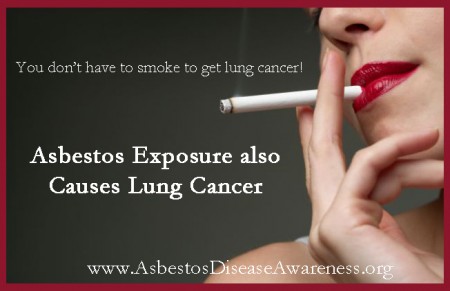Posted on August 1, 2014
 Today marks the 3rd annual World Lung Cancer Day (WLCD) to celebrate, commemorate & support the people affected by Lung Cancer.
Today marks the 3rd annual World Lung Cancer Day (WLCD) to celebrate, commemorate & support the people affected by Lung Cancer.
People often ask me – What’s the difference between mesothelioma and lung cancer?
Although both cancers can develop after asbestos exposure, mesothelioma is not lung cancer.
Malignant mesothelioma is a cancer that starts in cells in the linings of certain parts of the body, especially the chest cavity or abdominal cavity.
A layer of specialized cells called mesothelial cells lines the inside of the chest, the abdomen, and the space around your heart. These cells also cover the outer surface of most of your internal organs. The lining formed by these cells is called the mesothelium.
The mesothelium helps protect your organs by making a special lubricating fluid that allows organs to move. For example, this fluid makes it easier for your lungs to move (expand and contract) inside the chest when you breathe. The mesothelium has different names in different parts of the body:
- The pleura coats the lungs and the cavity containing the lungs in the chest.
- The peritoneum coats the abdominal cavity and many of the organs within that cavity.
- The tunica vaginalis coats the testicles.
- The pericardium coats the heart and creates the cavity that holds the heart in the chest.
Mesothelial tumors can be non-cancerous (benign) or cancerous (malignant).
 Lung cancer develops inside the lung itself.
Lung cancer develops inside the lung itself.
The lung cancer facts are staggering. An estimated 160,000 Americans died last year of lung cancer and it remains leading cancer killer. An estimated 224,000 people will be diagnosed with lung cancer in 2014. Although promising research continues, over half of people with lung cancer die within one year of being diagnosed.
While smoking is one of the main causes of lung cancer, around 14 per cent of cases are in non-smokers. Occupational, environmental, and air pollution carcinogens also cause lung cancer.
If you’ve been exposed to asbestos – stop smoking. Research has proven that “nonsmoking asbestos workers are five times more likely to develop lung cancer than nonsmokers not exposed to asbestos; if they also smoke, the risk factor jumps to 50 or higher.”
Join ADAO today to raise awareness and action prevent asbestos exposure to eliminate all asbestos-caused diseases.
Together, change is possible.
Linda Reinstein
SOURCES: The American Lung Association and American Cancer Society
